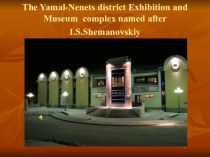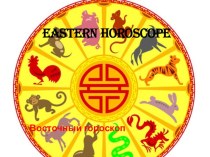- Главная
- Разное
- Бизнес и предпринимательство
- Образование
- Развлечения
- Государство
- Спорт
- Графика
- Культурология
- Еда и кулинария
- Лингвистика
- Религиоведение
- Черчение
- Физкультура
- ИЗО
- Психология
- Социология
- Английский язык
- Астрономия
- Алгебра
- Биология
- География
- Геометрия
- Детские презентации
- Информатика
- История
- Литература
- Маркетинг
- Математика
- Медицина
- Менеджмент
- Музыка
- МХК
- Немецкий язык
- ОБЖ
- Обществознание
- Окружающий мир
- Педагогика
- Русский язык
- Технология
- Физика
- Философия
- Химия
- Шаблоны, картинки для презентаций
- Экология
- Экономика
- Юриспруденция
Что такое findslide.org?
FindSlide.org - это сайт презентаций, докладов, шаблонов в формате PowerPoint.
Обратная связь
Email: Нажмите что бы посмотреть
Презентация на тему по литературе Англии на тему Развитие английского романса. Полная версия романсов о Короле Артуре Смерть Артура (11 класс)
Содержание
- 2. What is a medieval romance?What are the main themes of the romance in Middle Ages?
- 3. The legend of King Arthur and
- 4. Arthur’s FamilyFather: Uther Pendragon (King of Britain).Mother:
- 5. The castle had been a Celtic stronghold
- 6. TintagelMerlin’s Cave
- 7. Mythological FiguresLady of the Lake:
- 8. Merlin: Magician, seer, and teacher
- 9. Sir Lancelot: The bravest and
- 10. Guinevere: She is the wife
- 11. Round Table: According to one version it
- 12. The most popular origin of the table
- 13. In Christian mythology, the Holy Grail was
- 14. But there are other opinions, for instance
- 15. Camelot is the most famous fictional castle
- 16. ExcaliburArthur, reigning in his court at Camelot,
- 17. Of Arthur’s several enemies, the most treacherous
- 18. Avalon: In the Celtic mythology,
- 19. There were stories that even King Henry
- 22. Скачать презентацию
- 23. Похожие презентации
What is a medieval romance?What are the main themes of the romance in Middle Ages?
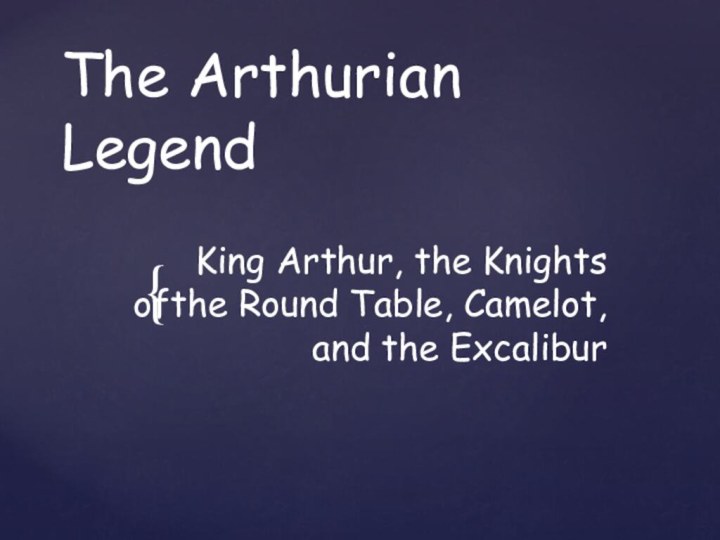
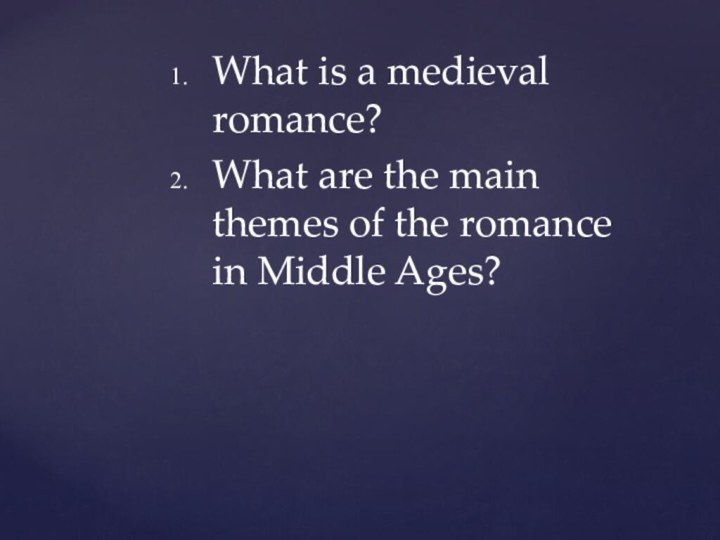
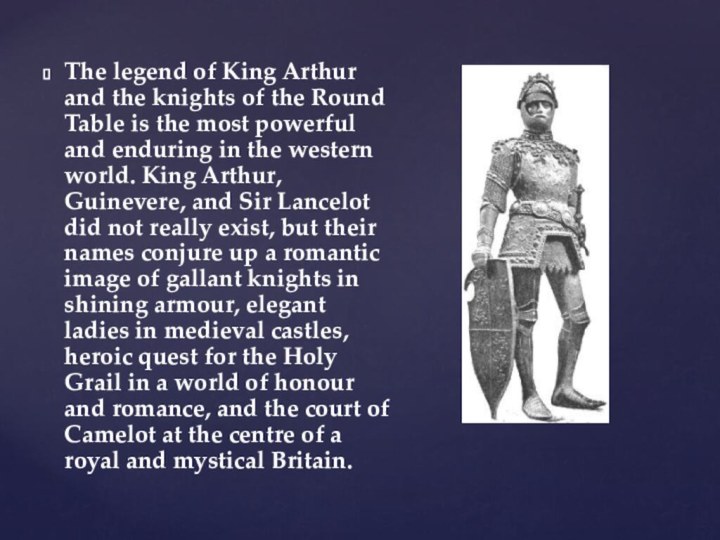
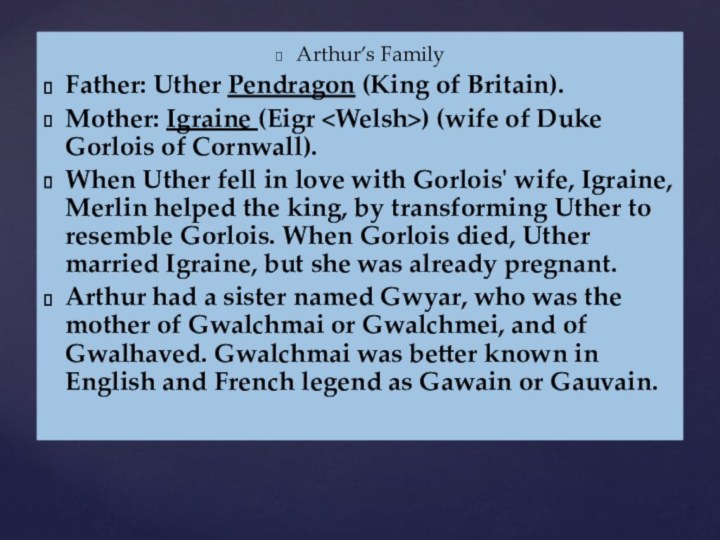





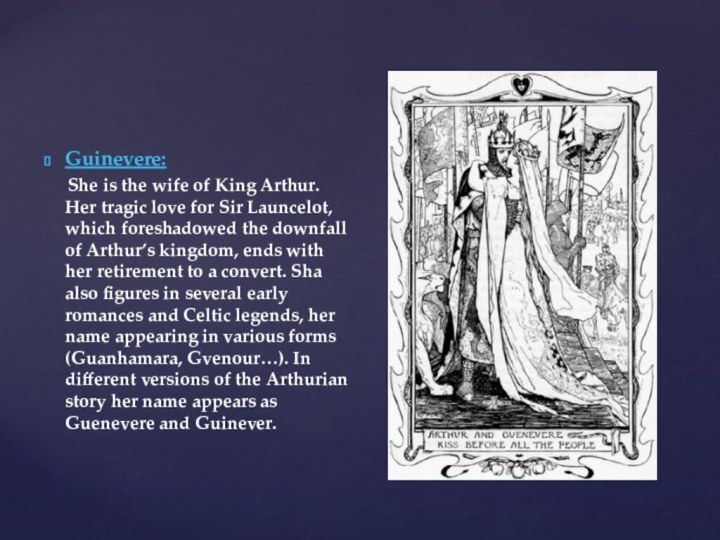

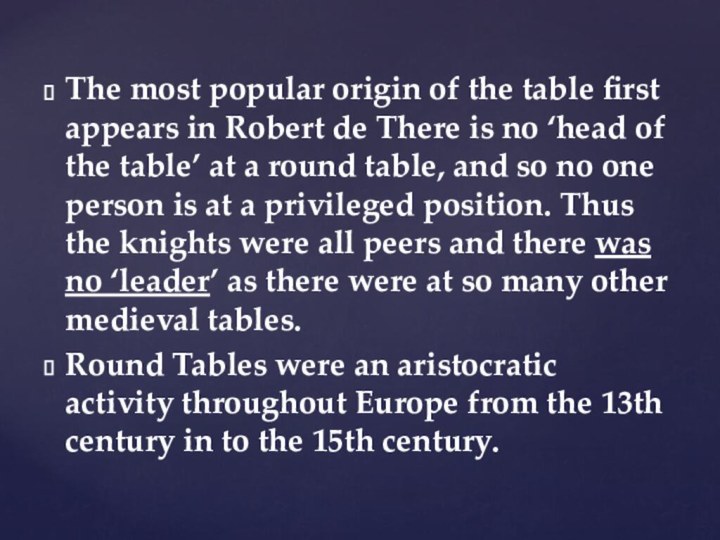
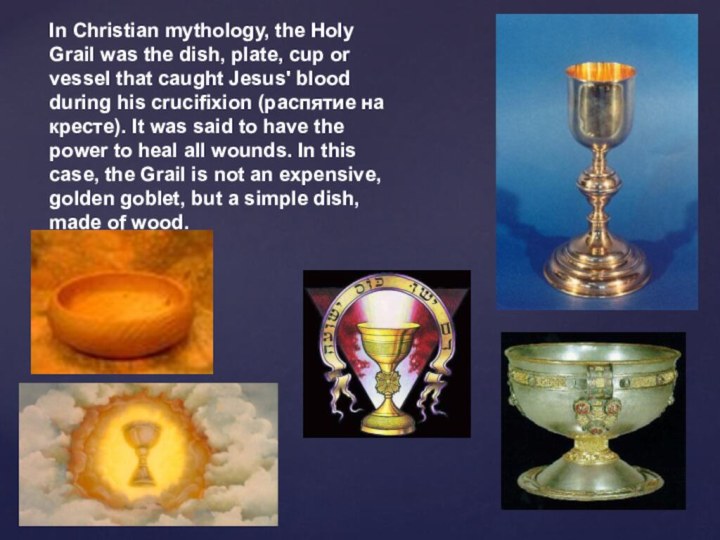
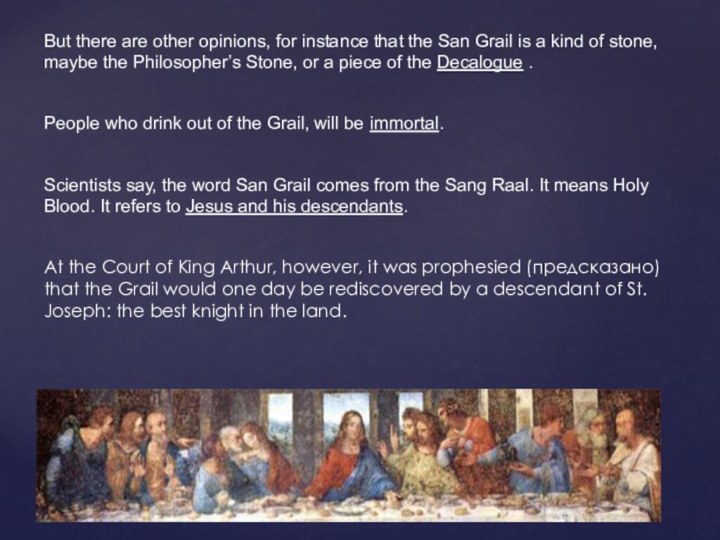
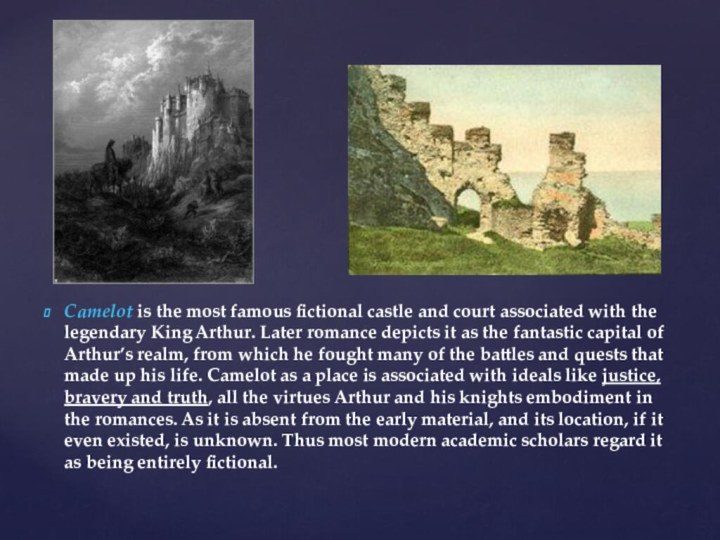
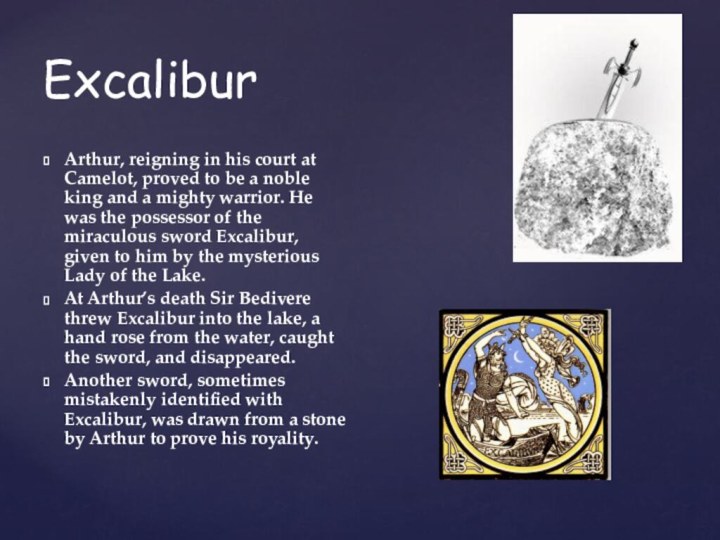

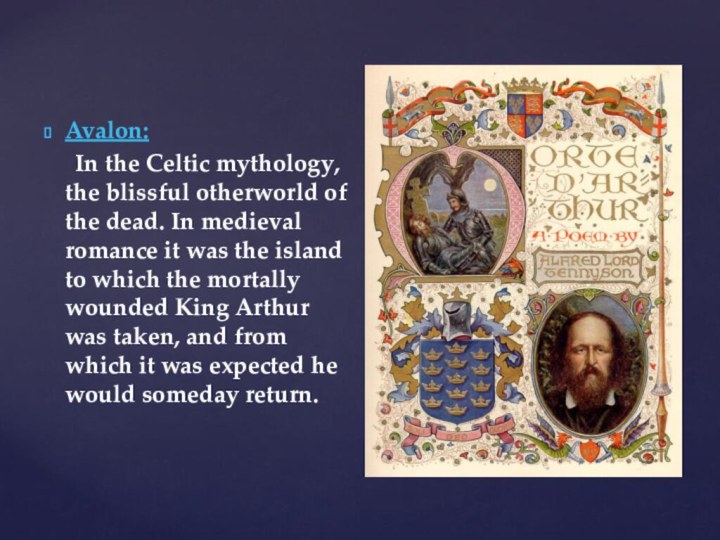
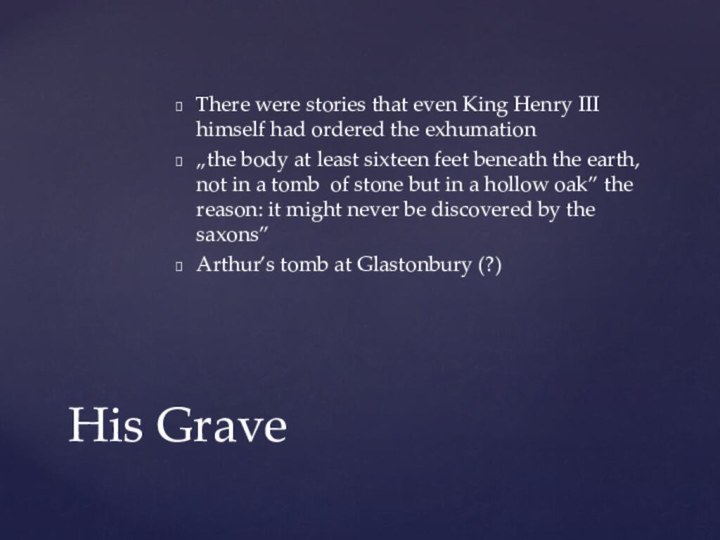
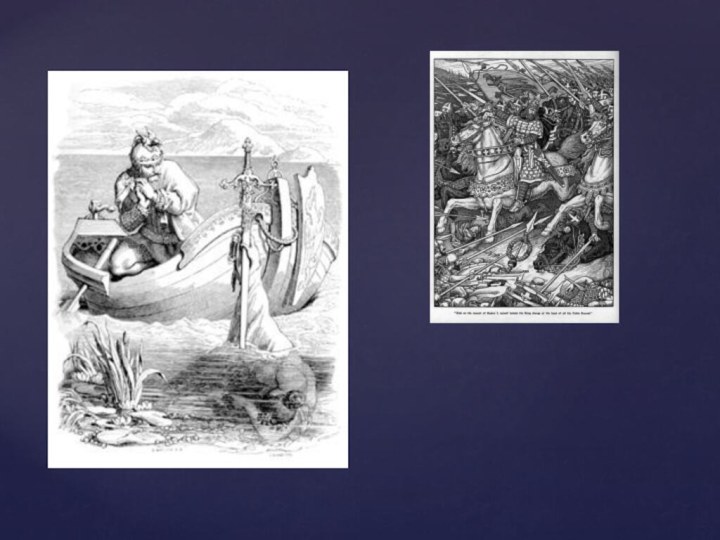


Слайд 3
The legend of King Arthur and the
knights of the Round Table is the most powerful
and enduring in the western world. King Arthur, Guinevere, and Sir Lancelot did not really exist, but their names conjure up a romantic image of gallant knights in shining armour, elegant ladies in medieval castles, heroic quest for the Holy Grail in a world of honour and romance, and the court of Camelot at the centre of a royal and mystical Britain.
Слайд 4
Arthur’s Family
Father: Uther Pendragon (King of Britain).
Mother: Igraine
(Eigr ) (wife of Duke Gorlois of Cornwall).
When
Uther fell in love with Gorlois' wife, Igraine, Merlin helped the king, by transforming Uther to resemble Gorlois. When Gorlois died, Uther married Igraine, but she was already pregnant. Arthur had a sister named Gwyar, who was the mother of Gwalchmai or Gwalchmei, and of Gwalhaved. Gwalchmai was better known in English and French legend as Gawain or Gauvain.
Слайд 5 The castle had been a Celtic stronghold before
becoming home to Earl of Cornwall
The legend says
this is the birthplace of ArthurTintagel
Слайд 7
Mythological Figures
Lady of the Lake:
A
misty, supernatural figure endowed with magic powers, who gave
the sword Excalibur to King Arthur. She inhabited a castle in an underwater kingdom. According to one legend she kidnapped the infant Launcelot and brought him to her castle where he lived until manhood. She has been identified variously with Morgan le Fay and Vivien. The poem The Lady of the Lake, by Sir Walter Scott, is based on a totally different legend.
Слайд 8
Merlin:
Magician, seer, and teacher
at the court of King Vortigern and later at
the court of King Arthur. He was a bard and culture hero in early Celtic folklore. In Arthurian legend he is famous as a magician and as the counselor of King Arthur.
Слайд 9
Sir Lancelot:
The bravest and
most celebrated knight at the court of King Arthur.
He was kidnapped as an infant by the mysterious Lady of the Lake, from whom he received his education and took his title, Launcelot of the Lake. As a young man he went to the court of King Arthur, where he was knighted and became one of the most feared warriors. Lancelot was the lover of Guinevere, his sovereign’s queen.
Слайд 10
Guinevere:
She is the wife
of King Arthur. Her tragic love for Sir Launcelot,
which foreshadowed the downfall of Arthur’s kingdom, ends with her retirement to a convert. Sha also figures in several early romances and Celtic legends, her name appearing in various forms (Guanhamara, Gvenour…). In different versions of the Arthurian story her name appears as Guenevere and Guinever.
Слайд 11
Round Table: According to one version it was
given to Arthur as a wedding gift by his
father-in-law. A round table of undetermined antiquity hangs now in the castle at Winchester. Tradicionally King Arthur’s, it may be a relic of one of the medieval jousts also called round tables.Слайд 12 The most popular origin of the table first
appears in Robert de There is no ‘head of
the table’ at a round table, and so no one person is at a privileged position. Thus the knights were all peers and there was no ‘leader’ as there were at so many other medieval tables.Round Tables were an aristocratic activity throughout Europe from the 13th century in to the 15th century.
Слайд 13
In Christian mythology, the Holy Grail was the
dish, plate, cup or vessel that caught Jesus' blood
during his crucifixion (распятие на кресте). It was said to have the power to heal all wounds. In this case, the Grail is not an expensive, golden goblet, but a simple dish, made of wood.
Слайд 14 But there are other opinions, for instance that
the San Grail is a kind of stone, maybe
the Philosopher’s Stone, or a piece of the Decalogue .People who drink out of the Grail, will be immortal.
Scientists say, the word San Grail comes from the Sang Raal. It means Holy Blood. It refers to Jesus and his descendants.
At the Court of King Arthur, however, it was prophesied (предсказано) that the Grail would one day be rediscovered by a descendant of St. Joseph: the best knight in the land.
Слайд 15
Camelot is the most famous fictional castle and
court associated with the legendary King Arthur. Later romance
depicts it as the fantastic capital of Arthur’s realm, from which he fought many of the battles and quests that made up his life. Camelot as a place is associated with ideals like justice, bravery and truth, all the virtues Arthur and his knights embodiment in the romances. As it is absent from the early material, and its location, if it even existed, is unknown. Thus most modern academic scholars regard it as being entirely fictional.
Слайд 16
Excalibur
Arthur, reigning in his court at Camelot, proved
to be a noble king and a mighty warrior.
He was the possessor of the miraculous sword Excalibur, given to him by the mysterious Lady of the Lake.At Arthur’s death Sir Bedivere threw Excalibur into the lake, a hand rose from the water, caught the sword, and disappeared.
Another sword, sometimes mistakenly identified with Excalibur, was drawn from a stone by Arthur to prove his royality.
Слайд 17
Of Arthur’s several enemies, the most treacherous were
his sister Morgan le Fay and his nephew Mordred.
Morgan le Fay was usually represented as an evil sorceress, scheming to win Arthur’s throne for herself and her lover. Mordred was variously Arthur’s nephew or his son by his sister Morgawse. He seized Arthur’s throne during the king’s absence. Later he was slain in battle by Arthur, but not before he had fatally wounded the king. Arthur was borne away to the isle of Avalon. Where it was expected that ho would be healed of his wounds and that he would someday return to his people.
Слайд 18
Avalon:
In the Celtic mythology, the
blissful otherworld of the dead. In medieval romance it
was the island to which the mortally wounded King Arthur was taken, and from which it was expected he would someday return.Слайд 19 There were stories that even King Henry III
himself had ordered the exhumation
„the body at least sixteen
feet beneath the earth, not in a tomb of stone but in a hollow oak” the reason: it might never be discovered by the saxons”Arthur’s tomb at Glastonbury (?)
His Grave





















